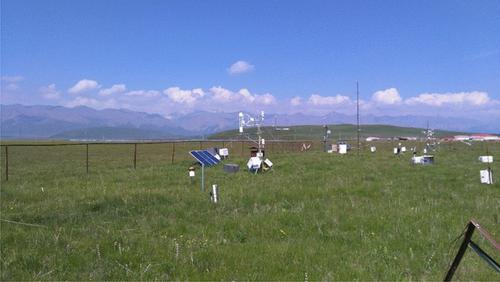Ecosystems ( IF 3.4 ) Pub Date : 2021-07-09 , DOI: 10.1007/s10021-021-00669-x Hongqin Li 1, 2, 3 , Gang Qin 1 , Yingnian Li 1 , Fawei Zhang 2, 3, 4 , Yongsheng Yang 2, 3 , Yikang Li 3 , Guangmin Cao 3 , Huakun Zhou 3, 4 , Jingbin Zhu 5 , Junbang Wang 6 , Mingyuan Du 7

|
Abstract
The terrestrial methane budget varies between different vegetation types and soil conditions and is highly uncertain for alpine grasslands. This work used eddy covariance techniques to continuously measure CH4 flux (NEEm) over a semiarid alpine meadow on the northeastern Qinghai-Tibetan Plateau from January 2017 to August 2019. The diel NEEm averaged 0.14 ± 0.98 nmol CH4 m−2 s−1 (mean ± S.D.), with a rough pattern of daytime release and nocturnal uptake. The 8-day NEEm exhibited a similar sinusoid variation, with a peak of 6.8 mg CH4 m−2 d−1 at the end of April and a minimum of −1.5 mg CH4 m−2 d−1 at the end of August. The maximum release probably coincided with the thawing of frozen soil in the root zone, and the peak uptake may be related to high soil temperature. Monthly CH4 uptake was highest from June to September and consumed 51.7 mg CH4 m−2 from the atmosphere. CH4 production in the other months totaled 647.6 mg CH4 m−2. The semiarid alpine meadow thus acted as a weak net CH4 source, releasing ca 0.6 g CH4 m−2 year−1 to the atmosphere. The boosted regression trees analysis shows that the sensible heat flux (H) is positively related to half-hour NEEm and accounted for 34% of its variability. The piecewise structural equation models reveal that the magnitude of the effects from soil temperature and vapor pressure deficit on 8-day and monthly NEEm were almost equal, but acted in opposite directions. Vegetation growth and soil moisture exerted little direct influence on NEEm variability at half-hour, 8-day, or monthly scales. Our results show that CH4 emissions of the nongrowing season dominate the annual methane budget for this alpine meadow area. Methane consumption during the growing season was significantly constrained by low soil temperature and high soil water content. These findings imply that semiarid alpine meadows may consume more methane during the growing season if soil temperatures increase and soil moisture levels decrease as projected by future warming scenarios, thus constituting a climate change negative feedback.
Graphic abstract
中文翻译:

青藏高原东北部半干旱高寒草甸非生长季排放对年度甲烷收支的支配地位
摘要
陆地甲烷收支因不同植被类型和土壤条件而异,并且对于高山草原具有高度不确定性。本工作采用涡流协方差技术连续测量了青藏高原东北部半干旱高寒草甸 2017 年 1 月至 2019 年 8 月的CH 4通量(NEE m)。diel NEE m平均为 0.14 ± 0.98 nmol CH 4 m -2 s -1(平均值±标准差),具有白天释放和夜间吸收的粗略模式。8 天的NEE m表现出类似的正弦变化,峰值为 6.8 mg CH 4 m -2 d -14月底和 8 月底最低为 -1.5 mg CH 4 m -2 d -1。最大释放量可能与根区冻土解冻同时发生,吸收峰值可能与高土壤温度有关。每月的 CH 4吸收量从 6 月到 9 月最高,从大气中消耗了 51.7 mg CH 4 m -2。其他月份的CH 4产量总计为 647.6 mg CH 4 m -2。因此,半干旱的高山草甸充当弱的净 CH 4源,释放约 0.6 g CH 4 m -2 年-1到气氛。增强回归树分析表明,感热通量 ( H ) 与半小时NEE m呈正相关,占其变异性的 34%。分段结构方程模型表明,土壤温度和水汽压差对 8 天和每月NEE m 的影响大小几乎相等,但作用方向相反。植被生长和土壤水分对半小时、8 天或每月尺度的NEE m变异性几乎没有直接影响。我们的结果表明 CH 4非生长季节的排放在这个高山草甸地区的年度甲烷预算中占主导地位。生长季节的甲烷消耗受到低土壤温度和高土壤含水量的显着限制。这些发现意味着,如果土壤温度升高,土壤湿度水平降低,如未来变暖情景所预测的那样,半干旱高山草甸可能会在生长季节消耗更多的甲烷,从而构成气候变化的负反馈。











































 京公网安备 11010802027423号
京公网安备 11010802027423号